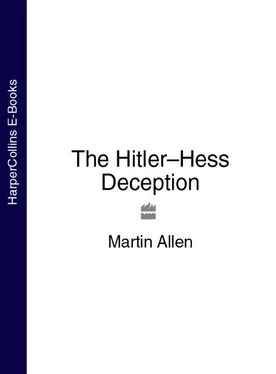However, in the atmosphere of diplomatic and international distrust that had developed by October 1939, British contemplation of negotiating peace with Hitler quickly began to evaporate. Dahlerus’s initiative failed, and the war continued unabated.
This, however, did not mean that Hitler gave up on the idea, and he continued secretly trying to find a negotiated end to the simmering conflict in the west before it came to the boil, ruining his timetable for eastern conquest. In truth he had no choice. He had found himself fighting the wrong war.
This situation led, between the summers of 1939 and 1941, to the British government receiving a great many German peaceable approaches. A substantial number of these can be discounted, for they included such low-level attempts as the German Chargé d’Affaires in Washington contacting the British Ambassador to inform him that ‘if desired he could obtain from Berlin Germany’s present peace terms’. 20On another occasion the British Legation to the Holy See reported that the Vatican would be prepared to arbitrate between Britain and Germany ‘through the Apostolic Delegate on the subject of Germany’s peace offer’. 21
Indeed, reports on the possibilities of peace were submitted back to London from far and wide – even from distant Angora, where Ambassador Sir Hugh Knatchbull-Hugessen reported that the ‘Netherlands Minister has sent me the following information regarding a conversation between Herr von Papen and Herr Hitler during the former’s recent visit to Berlin’. He went on to tell his seniors at the Foreign Office that ‘Herr Hitler discussed [with von Papen his] possible terms of peace’. 22
Each one of these reports required the attention of an Under-Secretary at the Foreign Office and the creation of its own file, and so became counted in the plethora of peaceable attempts made to the British government by German nationals or well-meaning neutrals. There were so many of these little snippets of peaceable intent that the whole matter of peace in 1939, 1940 and 1941 becomes rather a jumble, and to a large extent the important – real – peaceable moves made at this time have become hidden amongst all these lesser ones. However, it is possible to refine the plethora of peaceable initiatives down to just a few nuggets of gold – those that were stamped with the hallmark of Hitler.
There were basically three distinct strata to the peaceable attempts. The vast majority were low-level suggestions made by neutrals, junior German diplomats or the odd German official at loose in a neutral state. The second stratum, which was of some interest to the Foreign Office, emanated from respected neutrals, such as the King of Sweden, and upper-echelon German nationals, such as former War Minister Otto Gessler and even top Nazis such as Goebbels. These pitches for peace were made with an eye to the credit that would accrue to their originators, particularly with Hitler, if they brought Germany peace.
There was however, a third stratum of peaceable attempts, and these were of a different ilk altogether. They were top-grade offers that received the personal attention of the Foreign Secretary, and frequently the Prime Minister as well. Furthermore, there were occasions when these attempts were of such importance that they required the Prime Minister to consult the dominion heads of government in Canada, Australia, New Zealand and South Africa before they could be rejected.
The most intriguing fact about these top-grade offers is not only that they clearly emanated from Adolf Hitler himself, transmitted to the British authorities through his own personal emissaries, but that there was a discernible pattern to them. As each attempt failed or began to flounder, a new one was immediately initiated through another avenue to replace it, thereby creating an almost unbroken chain of peaceable attempts from the summer of 1939.
It was a situation that caused much interest and speculation within Britain’s Foreign Office and Intelligence Services. By the summer of 1940 it was realised that these secret Hitler-initiated attempts at peace mediation revealed a psychological flaw deep within the Führer’s character that Britain could, with skill and guile, exploit to Germany’s disadvantage.
Even as it became clear to Hitler that Birger Dahlerus’s attempts at mediation in September-October 1939 would fail, moves began to open another channel to the British government. However, the German Führer was still a relative novice at the art of opening secret lines of communication to Britain’s leadership, and rather than stepping back to assess the situation, calling upon expert advice before dispatching an eminent diplomat or well-respected neutral, he accepted the services of the SS. That was not a good idea.
On 17 October 1939 SS Colonel Walter Schellenberg was summoned to a meeting with the head of the Sicherheitsdienst (SD), Reinhard Heydrich, at RSHA (Reichssicherheitshauptamt – the Directorate General of Security for the Reich) headquarters on Prinz Albrechtstrasse in Berlin – a building it shared with the Gestapo, which reveals much about the RSHA’s interests. Ushered into the presence of this extremely dangerous man, second only to Himmler in the SD–SS chain of command, Schellenberg was surprised to find Heydrich in congenial mood. ‘For several months,’ Heydrich confided, ‘one of our agents in the Low Countries … has been in contact with the British secret service.’ 23He went on to inform Schellenberg that this agent, a man named Morz, had made several important contacts with British Intelligence, including two agents based in Holland. These were Major Richard Stevens, the Passport Control Officer at the British Embassy in The Hague (all Passport Control Officers were members of Britain’s intelligence service MI6, better known as SIS), and Captain Sigismund Payne-Best, who ran the Z Network in Holland (an intelligence-gathering unit which reported to Passport Control Officers). Schellenberg’s orders were to use these two men to ‘get in touch with the English government’ 24in order to initiate Anglo–German peace negotiations.
Within a few days of his meeting with Heydrich, Schellenberg found himself in Holland, under the alias of Captain Schaemmel of the Oberkommando der Wehrmacht (OKW) Transport Service, pretending to Stevens and Payne-Best that he represented a group of leading Wehrmacht officers who wanted peace. This pretence was almost certainly adopted not only to protect Heydrich and Himmler should anything go wrong, but also because the British would have blanched at finding themselves negotiating with the SS. Schellenberg offered the very tempting bait that his faction might even be prepared to accept conditions that limited Hitler’s position within Germany, although he stressed that it was desirable that Hitler remained head of state – which in Nazi terms meant that in public Hitler would have remained the German head of state in a purely ceremonial capacity, while in private he continued in charge. This curious suggestion was not as improbable as it might first appear, for the SS was all-powerful in Nazi Germany, and Himmler secretly harboured great ambitions for it, planning that it would eventually supplant the Nazi Party as the controlling power in Germany.
Within hours of his meeting with Schellenberg, Stevens dispatched a ‘most secret’ telegram to London, putting forward the German peace proposals and relating the remarkable suggestions concerning Hitler’s future status. He soon received a reply that stated:
In the event of the German representatives enquiring whether you have had a reply to the questions which you said … you would refer to H.M.G., you should inform them as follows ( not , however, handing them anything in writing):-
Whether Hitler remains in any capacity or not (but of course more particularly if he does remain) this country would have to see proof that German policy had changed direction … Germany [would not only] have to right the wrongs done in Poland and Czechoslovakia, but she would also have to give pledges that there would be no repetition of acts of aggression … 25
Читать дальше












